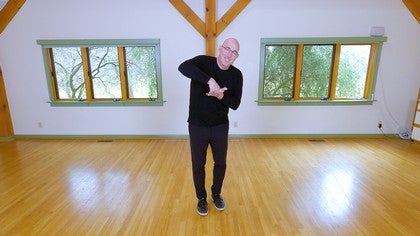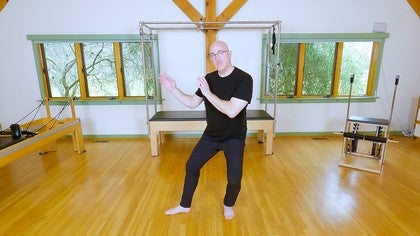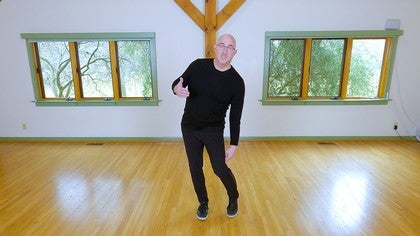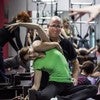Description
About This Video
Transcript
Read Full Transcript
We've talked about the anatomy and biomechanics of the knee, of a healthy knee. We've also talked about things that are very healthy for the knees. We've talked about ankle mobility, hip control, distribution of movement through the body, things that we do as Pilates teachers all the time. And then we talked about the biotensegrity model. And now we're gonna move into pathology, and I wanted to start out with pathologies of youth, particularly adolescent.
Because there are some very particular traumas and growing related injuries that pertain particularly to this age group that can affect them long term as they age. Many of the surgeries and the injuries that we incur in our youth do lead to some of the arthritic and osteoarthritic problems that we have later on in life, and we'll talk a lot about that in future lectures. So what I wanna do now is I want you to go back in your mind and think about the last lecture about things that are healthy for our knees, for our bodies, and think about how you would use those to work with the different pathologies that I'm gonna be discussing with the youth. In the developing child and up and through young adulthood, there are a number of injuries and traumas and things that are particular to them in that age group. One of them we're gonna talk about is growing pains, and that's a very real thing.
Having worked for years with ballet dancers, I always found it very interesting that a young ballet dancer, maybe in the age of 8 to 12, could acquire an incredible movement skill in their body. And then as they start going through puberty and started having growth, they had to change their strategies because the bones were growing faster than the muscles were lengthening. And it led to a number of different things that we would often categorize as growing pains. There also are some pathologies that upon really quick growth, that things can change in the growth plates. One in particular, it's very common, is Osgood-Schlatter disease that we'll talk a little bit about.
The other thing that I had mentioned earlier was this idea of patellofemoral alignment, and that when there is a malalignment of the patellofemoral, which I will state over and over again, usually due to a loss of hip control, that we talked about earlier, that as we control the hip strength, we can decrease that angle and that force that happens in the patellofemoral malalignment that we quite often see in young athletes. The other thing that we see a lot of is sport trauma. This could happen from external forces, I remember playing football and dislocating a shoulder when I was 16 years old and having to have surgery from that dislocation. It could happen from hockey, basketball, soccer, many of the contact sports that lead to external forces causing trauma. Another type of sports related injury is internal force, this is like wear and tear, this is overuse.
This, again, is that dancer that used to be able to do all of her pose, develop it without a problem, and then her legs got longer and now she had to cheat with her low back to be able to get the leg to come up because she didn't have the hamstring length anymore. So these repetitive strain injuries, these overuse injuries also can create problems, the runner, and it can go far beyond just the muscle skeletal system. For example, a lot of young female athletes are so active that they actually change their hormonal system in their body. They could be amenorrheic, meaning they don't have a normal period as they're maturing into years that they should be having periods. These are time periods where the bones are strengthening in that growth period, and if they're not having normal hormonal balances in their body because they are exercising too much, it can lead to structural problems in the future.
So two types of sports related injuries. One, obviously, trauma. Two is overuse or repetitive strain. So just keep that in mind. And again, most of these injuries of repetitive strain happen probably because of poor dynamic alignment or poor preparation of the tissue or overload of the tissues.
So you could also think about, as the Pilates teacher or the therapist, how do I manage behavioral aspects that might allow us to minimize the risk of these injuries? The next one is traumatic accidents. So we know it happens. There's so many car accidents, there's bike accidents, there's skiing accidents, skateboarding accidents. They happen all the time, and they're just a way of life.
I have always told my children I'd rather them be outside and have a traumatic accident falling out of a tree and playing outside than to be sedentary in the house. I think that the disease and the mental health of sedentarism is far greater risk than the risk of a traumatic accident maybe playing outside or sports or climbing trees or skiing. So this is just a parenting kind of philosophy. You can buy into it or not, I'm fine with that. The last one that I wanna talk about that does happen with children quite often in bone and muscle, and not meaning that it happens often to children, it's that the cancer happens with children more than it does with adults.
And that is different cancers, bone cancers, muscle cancers, blood cancers that children deal with, and the cancer itself could do harm, so they might have to have, you know, part of the knee could be damaged and they have a new knee put in. Maybe they have juvenile rheumatoid arthritis that causes harm to their growing joints. You could also see things that have a blood cancer that requires chemotherapy and radiation and treatments that can also do harm to joints, muscles, bones, et cetera. So these are all things that I find these categories that impact the juvenile or the young adult health of the knee. And these are things that we're going to look at.
This first slide that I'm showing here for juvenile or young adult related injuries is one of Osgood-Schlatter disease. And I hear this term quite often. I don't always see it as severe as we see in this particular x-ray here, but what Osgood-Schlatter disease is is the growth plate between the tibia plateau and the tibia is basically fractured or displaced. And that displacement can be incredibly painful, a lot of inflammation. The patella tendon comes down and attaches to it.
Where you see the arrow, that's where the patella tendon attaches. So the force, the grade force that goes through the patella into that tibial tuberosity that still isn't mature and fully grown into the tibia bone can be displaced and can lead to a lot of symptoms. So the treatment often is gonna be to modify load. It's going to be to take off extreme tensions of the patella tendon to let it go through the growth period. And once it goes through the growth period, quite often, it heals up just fine, it scars down, the growth plate closes, and they return to normal activities.
In this slide, we see what we refer to as patella femoral malalignment. And if you look on the left, you can see how the patella is gliding laterally in the groove of the femur. So typically, that patella should glide right in the groove. Now, this is not a dislocation. It's just a malalignment.
And I say just, it can cause a lot of pain and discomfort, and that pain and discomfort can also lead to weakness and lack of performance like any pain can. And when we look at this, we used to think that we wanted to strengthen, particularly, the medial quads, the vastus medialis muscle, especially the obliques, to be able to pull that patella back into alignment. But as I mentioned, Christopher Powers, a scientist, a physical therapist at University of Southern California had discovered that it really wasn't about the aligning the patella on the femur, it was more about aligning the femur underneath the patella. I think is a very important concept, I'll repeat it. It's not as much about aligning the patella on the femur.
It is more about aligning the femur under the patella. Well, where does femur alignment come from? Well, it comes from hip rotators. So you can imagine that if the femur collapsed in, especially on a single leg landing or deceleration, that's gonna create what we call a slingshot kind of effect on the patella. So just like the visual on the left, it's gonna create an angle on that patella like it wants to shoot out.
And so we'll get some mal tracking and some wear and tear on the underside of that kneecap. But the problem is not in the kneecap, the problem is up in the hip and the femur alignment. So we just wanna go back again to the previous lecture, good hip control can eliminate and improve significantly patella femoral malalignment. Hopefully we catch it before there's too many symptoms or degenerative changes that happen to the underlying cartilage. That's very important.
If it gets so bad that it just has arthritic changes, which does happen. I have patients now that are in their seventies dealing with basically arthritic changes underneath the patella. And they're debating, do I need a total knee replacement because this is so bad? Well, the knee replacement deals with the joint of the femur and the tibia, not as much with the patella. So there are other types of surgeries now where they put a button or things like that underneath the patella where it's been so degenerated.
We often hear the word chondromalacia, which is the softening of the bone underneath the patella. So again, going back to our healthy knee, good deceleration, good ankle dorsiflexion, 'cause remember, if I can't get good ankle dorsiflexion, a lot of times, my feet will turn out to be able to get that clearance. And that will lead to knees collapsing into the center, which leads to patella femoral malalignment. So think of it from the opposite ends of the knee, the foot and ankle, dorsiflexion, hip control in external rotation. In regards to other injuries and trauma, I'm going to talk about in the general public that has injuries, 'cause they also have sport related injuries, tendon muscle injuries, fractures, strains, sprains, et cetera.
But in particular for our youth and growing, we want to really focus on creating the optimal environment for them to move. And as I mentioned, during the growth spurt is the crucial time to make sure that our children are patient and that the teachers of children are patient while they're going through those growth spurts, focusing more on the quality of movement, things that we put a lot of emphasis on in Pilates, dynamic alignment, mobility, and posture that allow them to have the most optimal growth that gives them the longest life of sports and activities that they can hope for. And again, remembering that every child is different. There are familial trends of posture and injuries and diseases that are out of our control, and we just try to give them the most optimal body in which they can work with. Moving right along with different pathologies of the knee, I'm gonna start with those of tendons and muscles.
These are very severe injuries quite often when they happen. If you hear of a professional basketball player having torn their quad tendon or patella tendon, or maybe a sand volleyball player that tore their Achilles tendon, these injuries really take the power out of those joints. They're very important tendons, and they're very strong tendons. So the strains of tendons and muscles of the knee particularly revolve around the quad tendon, the patella tendon, and even in the ankle, the Achilles tendon, that will have a direct effect. 'Cause remember what I said, the gastrocnemius that goes into the Achilles tendon crosses the knee joint from below and attaches to the femur and the posterior side of the condyles.
So these all have an incredible effect on the knee's ability to perform. And depending on how severe it is and what the surgery is, quite often, the surgeon will remove the parts of the tendon that are too damaged to repair and that will result in a shortening of the tendon. And the shortening of the tendon can change the dynamics in a joint, and we just have to be sensitive to that and to work with the range. So you can imagine a patella tendon or quad tendon repair could result in decreased knee flexion. And an Achilles tear could result in decreased knee extension.
So these are things that we look at as we're moving them on the reformer, as we're moving to the tower bar, and looking to see if we can't gradually increase and adapt those tissues to be a little bit longer so the biomechanics of the knee, the patella, the ankle can work like normal, because if they don't, you can imagine, decrease ankle dorsiflexion, decrease knee flexion, there's gonna be an increased wear and tear on those joints. Another very common injury in the knee is the meniscal injuries. And the meniscus I mentioned in the anatomy portion is sort of the absorbing pad or disc inside the knee and would be comparable to the labrum in the shoulder, the labrum in the hip, the disc between the vertebra and the spine. And these are sorta like shock absorbers. And in the knee, they also create a cupping position.
So they allow for a deeper socket for the condyles to articulate in and also provide a lot of stability. Quite often when somebody has to have a mastectomy because of one of the injuries I'm gonna talk about, they will lose stability, and so there's more joint play. And even though the meniscus that was offending and causing pain is removed and they feel better, over the years, they're more likely to have increased rate of degenerative changes in the knee that result in arthritis and can eventually lead to something like a total knee replacement in their sixties, seventies, or eighties. So there are different types of meniscal injuries. And if you just look at the sort of sea curve of the meniscus, there's what's called a longitudinal tear.
And each of these, by the way, have different rates of outcomes. Some need to have surgery. Some don't. There's a huge amount of false positive that people who don't have knee injuries who've had knee MRIs and they show up that they have meniscal tears, but they've never had pain and they never remember an injury. Will talk about that a little bit later.
But the idea is that if there is pain and if it is showing that it's coming from the meniscus, the ultimate goal is to be able to repair the meniscus. Another very important factor about the meniscus is that there is blood source on the most outer layer of the meniscus. There is not vascular source or very much of it on the most medial or inside portion of it. So depending where the tear is, for example, if there is a oblique tear and it's just inside the inside lip of the labrum or the meniscus, the likelihood of it scarring back down because of bleeding is less likely than something that has like the longitudinal tear deep in the body, right? Deep in the body.
That's something that the doctor, and it's maybe a partial thickness can sew it back up and it'll heal up and it'll serve its purpose for many, many years to come. So each of these meniscal injuries have different prognoses, that means their outcome, they're projected outcomes, and it just depends and the surgeons have to look at this and weigh it out and go, is this non-surgical? Because a lot of them are non-surgical, and we treat them as physical therapists. Is it surgical and it just needs to be removed, a meniscectomy? Or is it something that can be repaired?
Is there enough blood supply? Can they use a fibrin clot? Can they use some different treatments to be able to get it to heal a little bit faster? So in the meniscal injuries, one of the things we wanna look at is how do we grade the load in the range of motion while they're in their healing phase? Whether it is nonsurgical, surgical, or surgical repair.
And the one thing we know in the surgical repairs, quite often, same thing in the hips with the labrum tears. If they repair them, they have a longer period of time to make sure that those tears heal up. And so we are to do very light partial weight bearing during that healing time, sometimes up to 8 to 12 weeks. So just something to keep in mind when you either have torn your own meniscus or you're working with somebody that has a meniscal tear. As I mentioned in the section on anatomy, the ligaments are really the stabilizers as well as the meniscus sort of holding the condyles in place on the tibia.
And the interesting thing about the ligaments is that they are not very elastic, right? We talked about muscles and tendons being elastic and fascia being elastic, but the ligaments are not as elastic. So they have a lot more collagen and less elastin in these fibers. They also are filled with proprioceptive receptors. Things like mechanicoreceptor, stretch receptors, pressure receptors, tension receptors that are interpreted by the brain as to where our body is in space when we move, right?
So when there is damage to these structures, we not only lose structural stability, but we also very likely lose that spontaneous proprioception in these joints. And so these injuries often do create a lot of havoc in the knee. And so these are injuries that are a little more severe. For example, women who play in basketball, soccer, field hockey have a very high incidence because of the Q angle of their hips and the nature of the sport that there are a high incidence of ACL tears. And these ACL tears get repaired, and it's not uncommon that young woman would have an ACL tear on the right leg and somewhere later in her career, she'd have an ACL tear on her left leg, for example.
So these are some genders, some ages are more susceptible to these types of injuries depending on the sport they play. In football, for example, with a penalty that's called clipping, clipping is illegal in the sport of American football because it's coming from behind and it creates what's called the terrible triad. So it's going to tear the anterior cruciate ligament. It's gonna tear the medial collateral ligament, and it's going to tear the medial menisci. And so these are types of injuries that come from trauma.
The doctors have to go in and figure out, is it surgical? Have they lost the stability in their knee? What happens when they lose that stability? Do I need to repair, replace, tighten? And those are the kind of decisions they make on these types of injuries.
And when you think of what these ligaments do, remember I said the media collateral is one that checks the abductor force on the knee. And the lateral collateral is the abduct force on the knee or the varus force on the knee. And the ACL is the anterior shift of the tibia, and the PCL is a posterior shift of the tibia. And I mentioned that the menisci are deepening the socket to keep the knee in place. So when any of these have been compromised, a lot of times, if we don't do the surgery or we don't rehabilitate them correctly, they will be on an accelerated path of degeneration in that knee because these are the structural providers.
Now, there are ways around it, and I'll share with you just a little bit is that muscular control of a joint, a co-contraction, we're talking in yoga about bandhas, this would be the genu bandha, the knees bandha, is a co-contraction around a joint complex. The problem with using genu bandha or using co-contraction is that muscles and tendons are always being reprogrammed. They don't have, you know, because they're elastic. So you have to do your exercises every day for the rest of your life if you wanna have proprioception. Think about those of us that have sprained our ankles multiple times.
If the ankle sprain was bad enough, that means the ligaments on the outside, the sprain of the ligament has been so damaged that it no longer provides all of that proprioception to our brain and to our spine. So we don't really know where that foot is, and so we quite often will resprain that ankle over and over again. Well, our way around that and avoiding surgery is we're gonna get the Theraband out and we're gonna do Pilates and we're gonna do foot intrinsics. And we have to do those almost every day to be able to maintain that proprioceptive awareness because within a couple days, we'll lose it. Where a normal, healthy, strong ligament, we don't have to do the proprioceptive training every day.
We just walk and move and it does it on its own. So these are some of the risk factors of injuries of the ligaments of the knee, the capsule of the knee. You know, there's quite often other, you know, if the trauma is so bad that it actually tears the ACL, there's probably trauma to the MCL and also to the menisci. Quite often when we talk about arthritis of the knee and it's sort of a scary term and a lot of us have it and a lot of people have it and don't even know about it, but the degeneration, and we talk about osteoarthritis, is where the cartilage on the femoral condyles is actually damaged. As in this picture, there could be an eroding or an exposed bone or just some damage, the meniscus is dehydrated and damaged.
There could be erosion underneath the patella. All of those could be considered osteoarthritis. And as a matter of fact, it's quite normal in the aging human. If we were to do an MRI of all adults over the age of 50, whether they ever had knee pain or not, we would find out that pretty much 80, 90% of us have degenerative changes that are just normal parts of aging. And we would see these type of things in our MRI.
That's a little disconcerting because anytime somebody has knee pain that's over the age of 50, they go get an MRI. The MRI's gonna show that they have degenerative changes, likely 90%. And the physician often will just make the decision there that the reason why they're having the pain is because of the degenerative changes in the knee. Where it might be something as simple as maybe when we watch them move, they don't have good dynamic alignment. They don't have proper hip mobility or control.
They don't have good distribution of movement in other parts of their body. I once had a patient who came to me that was being scheduled for bilateral knee replacements. And the doctor asked me if I would do the pre strengthening as well as the post rehabilitation for this woman. She was well into her seventies. And as I was taking her history, I found out that she had had bilateral hip replacements just four years before at the same time.
And on top of that, she had never had rehabilitation or worked out with a Pilates teacher or a trainer. She went right from the walker to walking in a collapsed fashion. So you can imagine her hip rotators had been cut for the old fashion hip replacement, posterior approach. They often don't bother to reattach the muscles. So her knees were collapsed into a valgus.
So for the past five years, she had been walking with a valgus strategy. And so when she came in, I was thinking like, is this really knee degeneration? Or is this poor dynamic alignment of her hips? So as we put her on the reformer, and we started to do footwork and on the chair to do some stepping and seated knee extension, we started realizing that she actually did have the ability to restore her dynamic alignment of the lower extremity. And it was enough that her knee pain reduced to the point that she no longer wanted to have knee surgery because she wasn't having pain.
So I wanna throw that out there that just because the MRI or the x-ray show the degeneration does not mean that that is what is causing the pain or the dysfunction. A lot of times, we have to go back, and I particularly love this area of looking to see what can we do to avoid a surgery at this stage of the game? Now, granted, I've had a lot of surgeries. You know, I went through a hip replacement. If you followed the total hip replacement on Pilates anytime.
And sometimes it just gets to the point where we can't function anymore. And when we lose function, we need to make decisions because function is more important than having all of our body parts, right? But a lot of times, I find that the symptoms that people are having are not necessarily related to or not provoked by the degeneration inside of the knee. There are other types of arthritis. I put up here rheumatoid arthritis.
Rheumatoid arthritis is an autoimmune disease. The body thinks the cartilage is actually a foreign body, and the macrophage is trying to eat it up and to get rid of it. So the body is rejecting our own joints. And in the olden days, we would see hands being severely damaged and big nodules and knees collapsing and gnarly feet and toes and jaw problems that were a result of the rheumatoid arthritis. But since maybe 20 years, the whole new pharmaceutical approach with biologicals and anti-inflammatories and working with autoimmune disease have greatly reduced the deformation of the joints that occurred because of this disease.
And a lot of times, if the, because it is an autoimmune disease, if the damage and the inflammation is enough, they also might warrant having total joint replacements to be able to stay active and function, and could be a really positive experience for them where once they have the total joint in, there's no longer an inflammatory response in that joint. So you'll see them often making and opting for surgical interventions. When we look at treatment of degenerative knee, it's very important that we take in a little bit of the history before we jump to conclusions, and we're going to progress this whole conversation for these modules into who needs to have a total knee replacement. But the aging adult, almost all of us are gonna have degenerative changes. So questions I ask, was there an old trauma that might be responsible for this?
Did it require surgical intervention? Even an arthroscopic procedure can lead to major degeneration over years. I had a meniscectomy and have lost the stability of my left knee years ago, and it's continuing to, you know, I do all I can, but it's getting to that point where it functions less and less and gives me more and more complaints and probably will result in a total knee, as we'll talk about in future modules. Is the residual knee unstable? So are the ligaments so unstable that there's just a lot of joint play and there's a lack of control in it?
Does the knee have full range of motion? So are they limited in their flexion? Can they go down on a squat? Can they not straighten, and I have a patient who can't straighten her knee because of a fracture of the tibia, and she's minus five degrees. Well, that has affected everything else in her body.
If she can't get her knee straight, she can't get her hips forward. If the hip flexors are tight, it pulls on her back. She's had five back surgeries. You start getting the idea that it's like this vicious cycle that's very hard to get her out of. And the biggest disturbance for her right now is the lack of knee extension.
So she has a loss of range of motion from one injury, the fracture the tibia plateau. How's the alignment of the knee? So for example, if the knee is really varus, is it real valgus, knock knee? What's going on with that alignment? How do they walk?
And also the duration of the pain. So a lot of people wake up in the morning with some arthritic pain, but they move around and they feel much better. Others might have pain for weeks on end that is not getting better even with therapy and with Pilates and with movement, doing all the right things, water aerobics, and they're still not getting better. So these are all things that we look at and we take into consideration as it pertains to what intervention do we do. When we look at arthritis and degenerative changes, we know that the best intervention for them, no matter what state they're in, is movement.
And so a movement helps preserve it, but it has to be good movement. It has to be high quality movement. If it has abnormal stresses or it's at the end of range, it's going to be something that could potentially perturb and cause more inflammation and more pain and more degeneration. And so asking these questions really helps us to understand how we best can intervene or help them in their process. This concludes the section on pathology and understanding the progression of pathology from childhood, adolescence, major trauma kind of injuries, and all the way up through degenerative changes.
I've tried to keep it relatively superficial, but cover a wide basis because education, once again, is the most important thing for us to be able to understand what's the next step. So in the next module, we're gonna be talking about treatment.
Knee Health: The Injured Knee and its Recovery
Comments
You need to be a subscriber to post a comment.
Please Log In or Create an Account to start your free trial.














